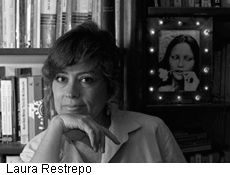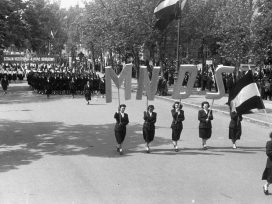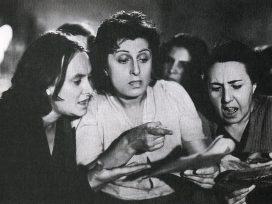Like many Latin American authors, Laura Restrepo’s biography includes dramatic politics. Politically active in her own country, Columbia, she participated in the Spanish resistance to the Franco regime and was committed to overthrowing the military junta in Argentina; she was a foreign correspondent during the US invasion of Grenada in 1983 and during the war between the Contras and the Sandinistas in Nicaragua; and in 1982 she was a member of the negotiating committee appointed by President Belisario Betancur to mediate between the M19 guerilla (the predecessors of the today’s FARC) and the government of Columbia.
 Again, like so many other Latin American authors during, Restrepo’s political activism the 1970s and 80s forced her into exile. While a mediator, her life was threatened on several occasions, and to ensure her personal safety she moved to Mexico, where she lived for six years. It was during this time that she wrote her first novel, the semi-documentary La Isla de la Pasión, published in 1989 to instant acclaim in the Spanish-reading world. Restrepo’s political curriculum vitae should also include that she was born in 1950 in Bogotá to a well-to-do family, that her father was a compulsive vagabond, and that she studied literature, philosophy and political science at the Universidad de Los Andes. She has written nine books, has been awarded a number of prizes and is considered one of the most significant voices in Latin America.
Again, like so many other Latin American authors during, Restrepo’s political activism the 1970s and 80s forced her into exile. While a mediator, her life was threatened on several occasions, and to ensure her personal safety she moved to Mexico, where she lived for six years. It was during this time that she wrote her first novel, the semi-documentary La Isla de la Pasión, published in 1989 to instant acclaim in the Spanish-reading world. Restrepo’s political curriculum vitae should also include that she was born in 1950 in Bogotá to a well-to-do family, that her father was a compulsive vagabond, and that she studied literature, philosophy and political science at the Universidad de Los Andes. She has written nine books, has been awarded a number of prizes and is considered one of the most significant voices in Latin America.
One way of summarizing her oeuvre would be to say that she explores the extremes of humanity. Her themes range from religious fanaticism to sexual obsession to social isolation. Recurring elements include the family, the clan and the isolated group, along with sex and romance. La Isla de la Pasión, a ingeniously constructed historical novel, is about thirteen soldiers commandeered with their families to a distant island in the Pacific. They struggle to develop a civilian society there, but one by one they fall prey to illness, starvation and internal discord. Eventually, only women and children remain; thanks to their reciprocal solidarity, they manage to survive for nine years until finally being rescued. Dulce Compañía (1995) is set in a poor mountain village near Bogotá. The inhabitants are convinced that there is an angel among them. The style of the novel is relatively mundane, the narrative technique simple. What grips the reader is Restrepo’s description of religion as being used to shape myths concealing sexual abuse and criminality. In La Novia Oscura (1999), prostitutes in Colombia earn their living selling sexual services to the foreigners working for the big petroleum companies. Since then Restrepo has written a further six novels, including the acclaimed Delirio (2004), about the drug trade in Colombia. Her most recent book is Demasiados Héroes (2009), a family saga set during the regime of the former Argentine dictator Jorge Rafael Videla.
Secret codes, new routes
Restrepo is one of the many contemporary Latin American authors seeking new routes for political writing. They reject both overt realism and phantasmagoria. Instead, their novels wander down less defined, more suggestive tracks: mysticism, irony, meta-literary games, and dreamlike, melancholy sequences are all recurring elements. Insensatez by Honduran author Horacio Castellanos Moya and Nove noites by the Brazilian Bernardo Carvalhos (both 2009) are two examples. In Moya’s novel, violence, paranoia and political oppression combine naturally with humour, sarcasm, and linguistic sensitivity. In Carvalho’s novel, by contrast, a mystical game with language, memory and genres lead the reader to perceive the wry, pseudo-scholarly story of anthropologist Buell Quain as pure detective fiction. Restrepo, too, has paved the way for a new kind of political novel, the clearest example of which is her second novel, Leopardo al Sol (1993). Set in Bogotá during the 1980s, the narrative is based on a number of real-life underworld events. Restrepo has described how the idea came to her as she began to ask how a country in which, for time immemorial, Christian morality and archaic social patterns had prevailed, could give way to a class of nouveau riche gangsters who wallowed in corruption and status symbols and assassinated judges, politicians and public figures. “This transformation”, she says, “was encumbered with secret codes I wanted to decipher.” Her research reportedly took eleven years. The result is a highly unusual narrative, a novel that was very timely when published, but that is difficult to read through a political prism if the reader is not familiar with Restrepo’s literary intentions.
One might say that it would be easy to take Leopardo al Sol for a pulp fiction thriller from the 1940s. The intrigue circles around two rival families, both of which operate in the Bogotá underworld. (Restrepo consciously avoids using words like drugs and narcotics, but it is easy to read between the lines and know that this is what is being bought and sold). The language is extremely hard-boiled. Vendettas and clan mentalities are the main themes, and Restrepo admits borrowing her narrative techniques from comic books, soap operas and action films. The intrigue is forced forward at full speed. There is certainly something provocative about this: a politically active woman starts writing in order to understand the degeneration of her country and, a decade of research later, ends up with something that could very well have been written by Mickey Spillane. What happened – did Restrepo get lost in the mix? On the contrary. The unholy alliance between high and low, between politics and the banal, is what makes the novel so interesting. From the point of view of language, it deviates from Restrepo’s other novels, but she is right on the mark in her use of the outdated pulp-fiction thriller genre to seek the answers to the mysteries of the world of crime.
The 1990s – a new woman?
Restrepo borrowed the title – Leopardo al Sol – from a novel by the eccentric Irish author Lord Dunsany (1878-1957). The quotation in its entirety is:
Beyond them lies a yellow desert, speckled by the shadow of the stones, and death awaits there like a leopard lying in the sun.
Lord Dunsany wrote numerous short stories in popular genres including fantasy, science fiction and detective stories. He is said to have always written with homemade quills and never to have reworked a draft. In his view, the only function of style was to adapt to the genre in question; when he was bored with writing he would simply insert a pastiche of something he had produced before. Restrepo’s introductory quotation helps set the reader’s compass from the outset, preparing her for a work of both genre literature and pastiche. Like Lord Dunsany, Restrepo adapts her style to her content. This explains why Leopardo al Sol is more than a run of the mill hard-boiled thriller.
Leopardo al Sol is one of the most hard-boiled novels in a decade notable for its plethora of hard-boiled novels written by women. The thriller, until then a genre dominated by men, experienced a major renaissance thanks to thick-skinned female protagonists including Patricia Cornwell’s Kay Scarpetta, Doris Gercke’s lesbian commissioner Bella Block, and Sara Paretsky’s private eye V.I. Warshawski. Still, none of these new female crime queens was quite as hard-boiled as Laura Restrepo. Admittedly – they all swore, drank and led rough and tumble lives, but the true hard-boiled nature of an author is reflected not in her lifestyle but in her narrative style. It is a matter of tone and attitude. To find the kindred spirits of Restrepo’s characters, we must turn to the world of film.
After the 1980s, a chilly decade marked by strict censorship in film, the 1990s arrived as a promise of better, freer, times. It was like knocking the plug out of the catsup bottle. Ridley Scott’s acclaimed Thelma and Louise (1991) was rapidly followed by a number of films about gangsters and outsiders, which did not hesitate to wallow in the pleasures of graphic violence: Tarantino’s Reservoir Dogs (1992) and Pulp Fiction (1994); Rémy Belvaux’s C´est arrivé près de chez vous (1992); Tony Scott’s True Romance (1993); Nicolas Winding Refn’s Pusher (1996); the Wachowski brothers’ Bound (1996); and Takashi Miike’s blood-drenched Black Triad trilogy and his violent yakuza epic Dead or Alive. Restrepo’s characters find their equals in these works. Their directors are her kindred spirits in terms of aesthetics, not only because they make criminality and outsidership cult, but also because they make them more realistic and less genre bound than ever before. Not only that, they do so with a smile and a nod to their predecessors – the forgotten directors of B movies, the scorned authors of the pulp thrillers, lesbian pulp, the spaghetti western, the old Kung Fu-masters, and the pseudonyms behind the pink Harlequin novels.
Surprisingly, inherent in this violent project was a newly-awakened interest in gender, and in scrutinizing and reformulating gender roles. In film this became clear with female characters such as Alabama Worley in True Romance, and in literature in the works of, for instance, Orly Castel-Bloom, Kirsten Hammann, Nina Bouraoui and Slavenka Drakulic. All these writers contributed to the creation of a new kind of female fictional character – one that dismembered, revelled in blood and guts, tortured infants, spoke incoherently, and acted contrary to all our preconceptions of the feminine. Leopardo al Sol contains many of the qualities that also characterize the other authors of Restrepo’s generation: speed, toughness, and a predilection for genres long looked down on as B culture. However, she does not indulge in irony, nor does she so much as begin to question antiquated patriarchal gender roles, as other filmmakers and authors of her generation do. On the contrary: Restrepo’s female figures (with a few exceptions, understood to be lesbian) are passive, simple-minded and duped. Trapped in the highly guarded villa forts of their families, they quarrel about whose space is whose, keep an envious eye on each other, and age before their time. In contrast, the men are as active, as malicious and understand each other just as perfectly as the gun shooters in a western. In fact, the opening scene in Leopardo al Sol could have been taken directly from a Sergio Leone film from the 1960s.
A vendetta with complications
A young Colombian, Nando Barragán, comes walking down an empty street in a sleepy desert town near Bogotá. The dirt road is swept by clouds of dust. Balls of tumbleweed roll past. The young man is nearly nude: all he has on is a loincloth and a pair of black Ray-Bans. An old Colt .45 hangs at his waist. Trotting along behind him, trying hard to keep up, is another adolescent, his first cousin Adriano Monsalve. The two are partners in a small-time booze and cigarette racket, and are killing the time drinking tequila while they wait for Adriano to catch the six o’clock bus to Bogotá. Drunk, Adriano begins dancing with and fondling an older woman, a “meal” that Nando has “already eaten”, as he puts it. The scene escalates and takes on a tangible sexual charge. Nando loses control. Wild with envy and blind with rage, he shoots his cousin dead.
That bullet becomes the first link in a decades-long chain of drastic violence between the Barragáns and the Monsalves. The Columbian code of honour holds murder of a family member to be one of the deadliest of sins; it is a declaration of war against one’s own flesh and blood, the only atonement for which is payback with one’s own life. Nando refuses, and the families become arch enemies in a conflict regulated by the rigorous vendetta rules of their forefathers: they may no longer live in the same community or be on each other’s territory. When revenge is to be exacted, it must be one on one, man to man. No third parties may be involved, and it is against the rules both to shoot a man who is neither armed nor forewarned, and to shoot a man from behind. Vendettas are strictly an occupation for men. Children, women and the elderly are excluded. A vendetta man only take place on a zeta, meaning either nine nights or one month or one year to the day after the murder. Thus all the other days of the year are safe, and everyone involved understands the web of traditions.
Twenty years after the murder of Adriano Monsalve, the two families are living in different parts of Bogotá. Like wasps in a hive, brothers and sister aunts and uncles, and generations of cousins live close together and watch out for each other’s interests. What began as small-scale crooked dealings in a rural village has become a full-blown criminal syndicate. Cash, weapons and narcotics are the bread and butter of the patriarchs of each clan, who rule their homes and their troops with an iron hand. Behind tinted, bullet proof windows of black Chevy pickup trucks, ornamented with fiery decals, they glide down city streets, constantly protected by a caravan of bodyguards in metallic Toyota jeeps. After decades of bloodstained revenge, the dreaded zetas now fall at least once a month. Laura Restrepo sets the opening of her narrative, in the midst of this controlled chaos, in an atmosphere permeated with terror and paranoia.
At the head of the Monsalve family we find Don Mani and his wife, former beauty pageant queen Alina. They have built themselves a ranch, a little Garden of Eden far from all the horror. Don Mani vowed to Alina that they would move there and start a family, but the years have passed and Mani’s involvement in the underworld has increased rather than declined.
Across town, Nando Barragán holds the fort for his family. Having survived innumerable attempts on his life, he now finds himself surrounded by an entourage of more of less disturbed bothers, including Narciso Barragán, with his mad epileptic glare and his brilliantined beard. He drives a stretch, purple Lincoln Continental and is otherwise known as El Lirico, the poet, thanks to his passion for belting out romantic ballads. Another of the brothers is Arcángel Barragán, still a teenager, who lives his life penned up in a specially constructed room Nando has had made to protect him from harm. He is looked after by an elderly aunt, La Muda, who has taken a vow of virginity and wears a chastity belt. At regular intervals she hires whores for Arcángel to keep him from turning out retarded. Through a hole in the wall, La Muda masturbates covertly as she watches her nephew copulate. La Mona, a muscular sister with gold-capped teeth, supervises the weapons stockpile. She swears like a man and has dedicated her life to her only two interests: machine guns and soap operas. And of course there is the eternal matriarch, mamma Severina, keeping watch over them all.
Hard-boiled class perspective
At the opening of the novel, after twenty years’ thirst for revenge, Mani Monsalve has decided to violate the rules of his forefathers and hire a hit man to unscrupulously assassinate the Barragan brothers in cold blood, one by one. Will he succeed? As the threat of annihilation draws closer and closer for both families, the story works circles in on this eccentric gallery of characters. There is virtually no development of the male characters or their personalities. The aim is not – as in sophisticated novels and art films – to allow for interpretations or conclusions on the basis of what the characters say or do. Rather, more like in a Harlequin paperback, the author tells us how it is. Or rather, how the characters are.
In the work of Restrepo, as in the noir thriller, the authoritarian voice of the narrator comprises the core of what the reader perceives as hard-boiled. With its overloaded metaphors and extremely extended similes, it creates a fateful fantasy world peopled by mythical men who live and move in a vacuum beyond the law. For instance, after a night marinated in spirits, Nando Barrigán shoves his hundred thousand dollar car over the edge of a cliff, for no other reason than boredom.
If this novel had consisted solely of the narrator’s language, however, it might have been pure pastiche. Instead, and to undermine the authoritarian element, Restrepo adds other voices, anonymous and italicized, associating back to the oral tradition or, as Restrepo herself might say, to gossip. These are the “voices of the people”, voices from the neighbourhoods of both families, which always begin by saying: “People say…” or “I’ve heard…”
Restrepo’s works always display a clear awareness of class, often manifested in the idea of good versus bad taste, irrespective of whether the person in question is “old money”, nouveau riche or destitute. There is never any doubt that both gangster families are nouveau riche upstarts. They adore their shiny cars, their flashy gold chains and their street smart American clothes, just as they adore mamma’s beans and the local variant on Coke, Kola Román. They have endless resources and never hesitate to spend their money when opportunity knocks – for example when Narciso buys Nando a gigantic, circular waterbed with a tortoiseshell frame, mirrors, a minibar and a real fur bedspread as a wedding present, or when Mani hires a personal “image consultant”, Miss Melba Foucon, in order to rid himself of his gangster stamp. She persuades him to buy a fully-furnished colonial mansion, complete with a homosexual butler and family portraits in oils, from a distinguished family giving up their ancestral home. In the absence of class, no money in the world will do. Yet Mani chooses to go his own way, returning to his vulgar upstart home and his American jeans. His argument for the benefits of the new and practical (plastics, electronics, and flashy silk and artificial furs) over the hereditary and uncomfortable (solid wood, nineteenth century style, cotton and starched linen) makes him unique.
But back to Restrepo’s original question: how could Colombia have degenerated? Her choice of theme for this novel may be read as an extension of or an answer to this question. What Restrepo gets at in Leopardo al Sol is the very essence, the putty of what holds gangster families together, and what drives the men who head them.
Pastiche on her own terms
It is fascinating to an inveterate Spillane reader to see how Restrepo, in terms of her characters, has allowed herself to be so successfully inspired by pulp thrillers and film noir. Mickey Spillane and his successor James Ellroy are the unsung heroes of hard-boiled fiction. At the height of his career, Spillane was as detested for his misogyny, homophobia and racism as he was loved for his solitary, communist-hating protagonist. His enormous popularity was can probably be attributed to the fact that he succeeded, better than any other author of his day, in depicting the lost ideal of masculinity. Even before Spillane’s death, the values expressed by his protagonist Mike Hammer were becoming increasingly outdated and anachronistic. Hammer, in the illustrious company of Sherlock Holmes, Batman, James Bond and other twentieth century men, has been interpreted in later years as the epitome of a bygone society, in which women are women, men are men, and the lines of demarcation between races, nationalities and the sexes are clear and distinct. Authors like Tolkien, too, base their worlds on this traditional utopian dream. But in contrast to Tolkien’s nationally-minded hobbits and elves, the hard-boiled gangster hero is free from every form of tie – like his kindred spirits in adventure books, secret agent movies, and superhero comics, he is rootless, classless, self-sufficient and independent. Anything that might threaten to bind him also threatens to restrict his freedom and to undermine the boundless outsidership he has made his own. This ideal – taken to its extreme in the dream of a racially pure male domain based on masculine authority – survives today only in extreme environments such as certain military, political or religious enclaves, and in criminal milieus like that of the Colombian drug trade. And, of course, in popular culture.
Spillane constructed his utopias by restricting the movements of his protagonists to the world between their apartments and the bars frequented by underworld characters. In that world, individualism, violence and brute force continued to prevail, and fists and revolvers, rather than an external authority, or a modern democratic collective, determined who was strongest. Most importantly, women were not as yet involved. In the world created by Laura Restrepo, things are not very different. The Monsalve and Barragán families are entrenched in their hermetically sealed world, where time no longer exists. Only by closing society out and raising themselves above the law can they continue to live according to their own anachronistic rules. It is of interest to note that the overarching threats are the same for Mani Monsalve and Nando Barragán as for Mike Hammer. More menacing than the law, more menacing than enemies, more menacing than democracy, in fact more menacing even than death, are women.
This may sound absurd – very few of Restrepo’s women or those of her predecessors pose any actual, physical threat. In an interview, she described having added some of her female characters retrospectively, to lighten up the exclusively male, hard-boiled atmosphere, and to demonstrate the importance of nurturing the children, who represent the survival of the clans. Otherwise, the most prominent feature of the women in these novels is their involvement in internecine warfare. While for the men success demands discipline, collaboration and respect for the hierarchy, it is clear that the subjugation of the women is built on their inability to cooperate, or even to stay on speaking terms. In this genre, men’s inherent horror of women (which sometimes also extends to gay men) may be seen as having a logical explanation. The fundamental trait of classical gangster masculinity is the ability to be cool or, as Quentin Tarantino’s gangsters put it, “to stay cool”. This implies never losing face, always being tough and remaining in control. The hard-boiled male who manages to stay cool fulfils the utopian dream of total freedom. In True Romance, when Clarence Worley has shot the bad guys dead, stolen their stash of drugs and rescued his female in distress, he is awarded with the highest praise a man can receive: “You’re so cool!”
In the genre of the noir thriller, the female threat takes on further complexity. This is precisely what makes Mike Hammer so interesting in this context. In contrast to many other gangster heroes, he is, paradoxically, so full of emotion that his whole life has become an ongoing struggle to “stay cool”. The moment a woman appears in his world his legs go to weak. The scent of a woman suffices for his manly bravado to dissipate, and his fear, alas, is often justified. In the works of Spillane, the most beautiful women are always those with the most evil intentions. The worst moment for Mike Hammer is when the woman he is planning to marry turns out to be a vicious transvestite who wants him dead. Restrepo’s gangsters have this same fatal character flaw. Constantly aware of the fact that the slightest crack in the façade will result in their instant demise, they struggle desperately against their passions and urges, against the women they are unable to refuse, and without whom their lives would be utterly meaningless. Caught between the desires of their women for normality and the demands of their clans for loyalty, they make fateful decisions. Like an omen of new times, Restrepo’s male characters all suffer horrible destinies. Mani’s love for Alina is the death of him. In the closing scene, Nando Barragán, the living legend (who wed Ana Santana in a marriage of convenience, though she meant nothing to him), succumbs to death. After his rivals have finally been done away with, there is no reason to go on living.
It may seem odd to compare Mike Hammer, hero of the 1940s, with characters involved in international narcotics trading today. Yet Laura Restrepo made the conscious decision to dress her narrative in pulp thriller guise, and to point the reader in a specific direction by quoting Lord Dunsany. Nor is she alone in these choices. Many authors in the generation of Latin American literature that followed the boom of magical realism have sought new literary forms of expression to encompass the political. Horacio Castellanos Moya, mentioned early in this article, has stated firmly that he does not write political fiction, and yet he is considered a typical example of precisely that: the new generation of political novelists whose angle on politics is more from inside the labyrinth of the human psyche than from the external, societal perspective. There is every reason to read the work of Laura Restrepo through the same lens. I am certain that were she asked whether it is all right to joke about something as serious as the Columbian narcotics trade, she would reply that Leopardo al Sol is anything but a joke – it is a playful investigation of the ideals of masculinity and the culture of honour that bind criminal gangs together. If the corollary question were asked, whether it is all right to be playful about politics, she would respond, with the endorsement of a number of other authors of her generation, in the affirmative.
As long as you are deadly serious.

 Again, like so many other Latin American authors during, Restrepo’s political activism the 1970s and 80s forced her into exile. While a mediator, her life was threatened on several occasions, and to ensure her personal safety she moved to Mexico, where she lived for six years. It was during this time that she wrote her first novel, the semi-documentary La Isla de la Pasión, published in 1989 to instant acclaim in the Spanish-reading world. Restrepo’s political curriculum vitae should also include that she was born in 1950 in Bogotá to a well-to-do family, that her father was a compulsive vagabond, and that she studied literature, philosophy and political science at the Universidad de Los Andes. She has written nine books, has been awarded a number of prizes and is considered one of the most significant voices in Latin America.
Again, like so many other Latin American authors during, Restrepo’s political activism the 1970s and 80s forced her into exile. While a mediator, her life was threatened on several occasions, and to ensure her personal safety she moved to Mexico, where she lived for six years. It was during this time that she wrote her first novel, the semi-documentary La Isla de la Pasión, published in 1989 to instant acclaim in the Spanish-reading world. Restrepo’s political curriculum vitae should also include that she was born in 1950 in Bogotá to a well-to-do family, that her father was a compulsive vagabond, and that she studied literature, philosophy and political science at the Universidad de Los Andes. She has written nine books, has been awarded a number of prizes and is considered one of the most significant voices in Latin America.




